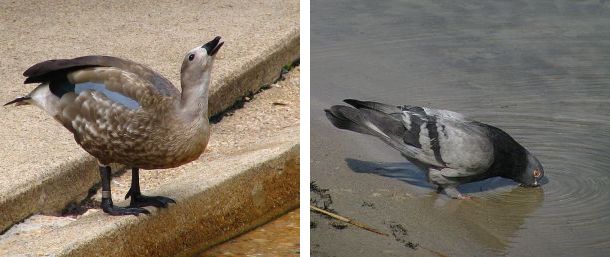
If you have a bird bath I’m sure you’ve noticed a lot more activity there during these long, hot days.
Tuesday evening my bird bath was so popular that nine birds lined up waiting while a robin monopolized the water. The group included song sparrows, mourning doves, starlings and house sparrows.
When the robin finally gave way it was fascinating to watch everyone drink. All of the birds except the doves put their beaks in the water then turned their faces to the sky to swallow, just like the blue-winged goose pictured at left.
The doves were different. They put their beaks in the bird bath and sucked up the water like the pigeon shown at right.
Why do they drink so differently?
The answer is complex and depends upon the species. It’s partly related to their anatomy (#4) and partly style. Birds have at least five different ways of drinking:
- Sip and Tilt up: Most birds use this method (and the next one) to collect water in their beaks. Then they turn their heads up to send the water to the back of their throats.
- Suck and Tilt: Looks a lot like the first method but is quicker because they collect a lot more water by actively sucking it up.
- Sucking without raising their heads: This is the method favored by Columbiformes (doves and pigeons) and helps identify birds as members of this order.
- Tongue drinking: Birds who sip nectar are experts at this method because their tongues are specially formed for their favorite food. Watch hummingbirds and nectar eaters, such as lorikeets, and you’ll see them use their tongues to drink.
- Drinking in flight: Swifts and swallows skim the water with their lower jaw, scoop up the water and swallow.
Next time you quaff a cold beverage, think about which method you’re using.
(photos from Wikimedia Commons. Click these links to see the original photos: blue-winged goose and rock pigeon)

Fascinating! I did not know that pigeons & mourning doves drink differently from other birds, because I had never paid that much attention, and it seemed like they all threw their heads back. I’ll have to be more observant.
There are three birdbaths scattered around my yard and they have also been “hot” beds of activity lately. I love watching when the birds actually get into the water. Robins and starlings bathe with abandon, splashing the water in all directions, while the smaller birds are more delicate in their movements. The birdbaths are also very popular with the deer in our neighborhood.
Thanks for the bird anatomy series, Kate. There’s so much to learn and you make it fun.
Well now it is evening & of course we have all these puddles in the parking lot; I see birds out there drinking all kinds of ways. Never paid attention much either. Thanks again Kate for the lessons.
Super interesting! I’ve learned something new
Kate — I went out and bought a bird bath 2 weekends ago(to capitalize on my neighbor’s feeders and indulge my new found interest in birds!) and finally had several different birds visiting it this weekend…. and I got to use my knowledge of how birds drink, as one of the visitors was a mourning dove! Thanks for the lesson!
Thanks for this information. I was just watching the birds outside my window and noticed that the mourning doves were not tilting their heads to drink. So I had to search for an answer and it brought me here. Nice to discover your blog.
Ive noticed for some time that mourning doves drink water differently but still dont why.